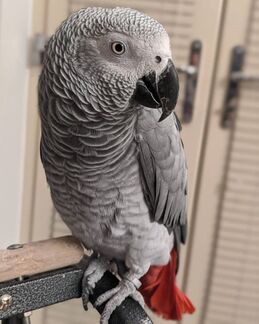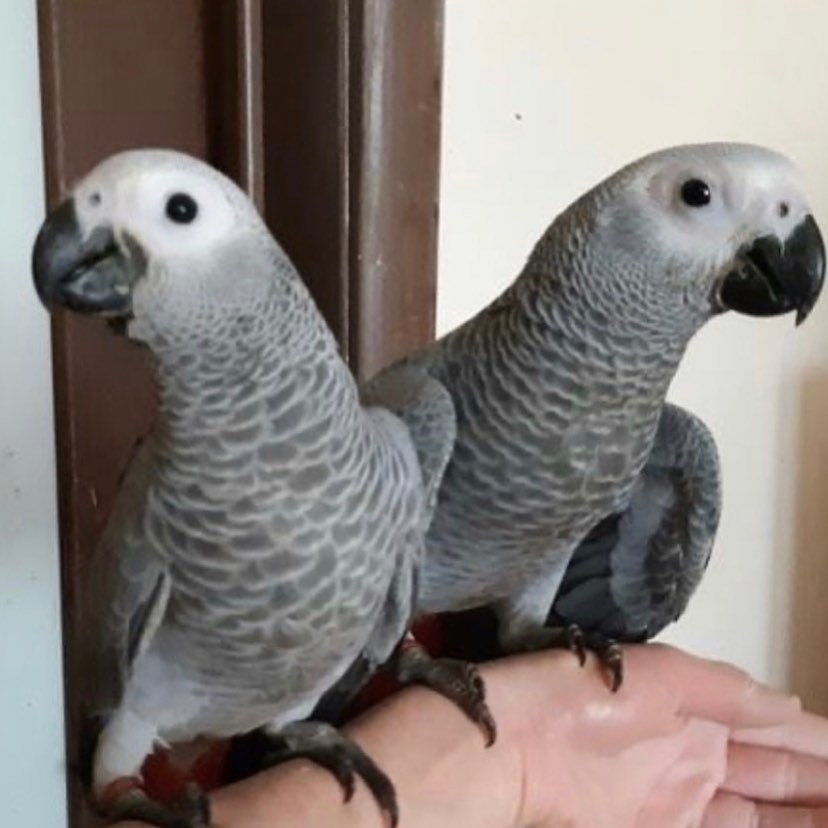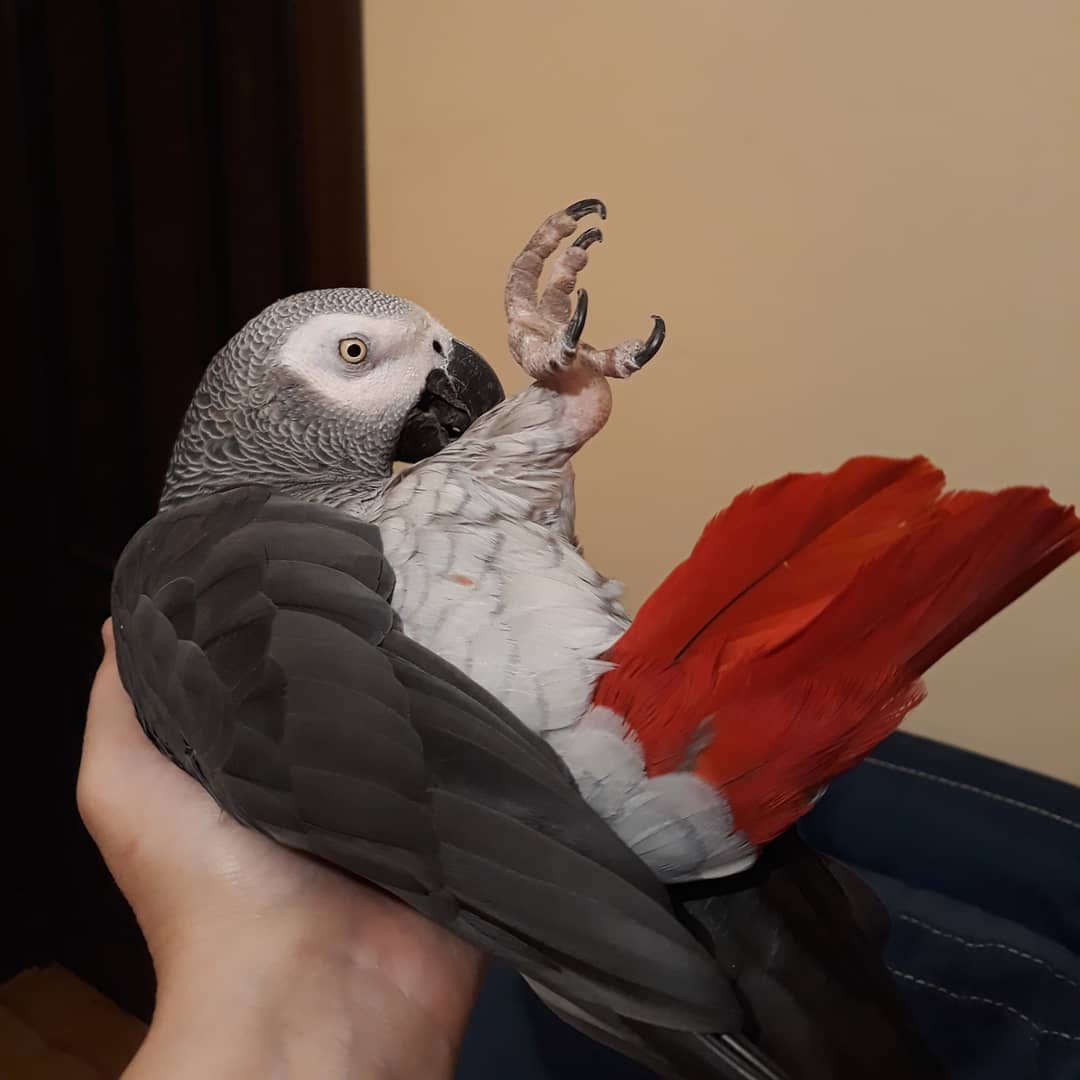AVAILABLE BIRDS FOR SALE
AGE - 6 MONTHS
|
matt and fiaz
|
jeremy
Meet Jeremy a cute African grey parrot just waiting to be taken home by the perfect person. He is cute and a fun loving bird.
|
AFRICAN GREY PARROTS FOR SALE
The African gray parrot is a medium sized parrot of about 10-14 inches, which also makes it an ideal pet as it is easy to keep and handle. Not surprisingly, the male is larger than the female, but not much larger.
African grey parrots have many attractive features, and parrot lovers will find that an African grey parrot is one of the easiest pets to keep. Not only that, the African gray parrot is a very popular pet parrot for many reasons. Its exceptional cognitive and conversation skills allow them to interact well with its owners, and it is a pleasure to have as a favorite pet.
Although they are very similar in appearance, there are two different species of African parrots. One is the African Congo Grey, which has a light grey body, a very light grey to white on one side of its head and a bright red tail. The other is the Timneh's African Grey with dark grey feathers on top, light grey on the chest and a chestnut brown tail. The general body shape of both parrots is very similar in both sexes, but the female tends to have a slightly narrower head and a thinner neck than the male.
When you think about the lives of other parrots, it is not surprising that the African grey has a longer life span. Therefore, it is important that the owner can make a long-term commitment to the parrot if he or she decides to accept it as a pet. They can actually live up to 60 years, which is quite surprising when you think of the family's usual pet.
In their natural environment, African grey parrots fly in a flock, so they tend to treat their owner as one of the flock. For this reason, the parrot often enjoys having its head rubbed on the side and/or even a small scratch, but it does not enjoy having its body manipulated. You will often find that in a group of parrots, they tend to kiss and smooch around each other's heads. This is a parrot's habit.
PLAY TIME OF MY PARROTS
we expose our children to various play environments that, if moved correctly, help them to develop muscles and a relaxed posture
Flying is one of the fundamental principles of parrot breed. Although all animal lovers or owners have their wings clipped to avoid damage in the house, young parrots need to be thought how to fly. When you take care of your pets, you should consider their need to learn this skill in their lives. The landing and graceful maneuvering of their wings are skills they need to show off. In terms of emotions, this can help your parrots interact more and more with you and become more attached to you. Are you thinking of taking care of the parrots yourself? Ask a parrot lover and they will know what they are doing and how the young parrots interact.
We believe in weaning our chicks (baby birds) according to their individual needs and level of maturity. All chicks should have a good start in life, both nutritionally and psychologically. each of our chicks is given a manual feeding formula that best suits their species and individual needs. they are exposed to a variety of foods from an early age.
The African Congo grey (Psittacus erithacus erithacus) is the named and most popular grey among the subspecies we see in the pet trade. Perhaps it is due to the attractiveness of its brilliant red tail. Congo Grey is the largest of the two subspecies. Other common names are: The Greys of Ghana, Togo, Cameroon and Angola, but they're all the same subspecies.
The so-called Psittacus erithacus erithacus originates from different regions or countries in Africa. The regional origin explains the differences in colour and size.
The African grey parrot from the Congo has shades of grey that cover its body. The feathers appear darker on the head and gradually lighten until they change to a light silver-grey towards the chest and legs. The darker feathers seem to have a jagged white edge, but if you look closely, many of the silver feathers have the same white tips. The wings are darker and the primary feathers are a very dark grey to almost black. The eye area has no feathers and is actually a shiny white patch of skin. When you hear a grey parrot "blushing", it describes this white patch of skin that turns pink. The toenails and beak are solid black, and the most magnificent finish of the Congo Grey parrot is its bright red tail.
African Grey Timneh
the African gray-parrot of Timneh (Psittacus erithacus timneh) is the smaller of the two subtypes of the African gray-parrots. The popularity of the smaller Congo cousin has grown in recent years. The African grey timneh comes from a smaller area of Africa, which includes Liberia and the Ivory Coast. The Timneh grey is a much deeper shade of grey than the Congo grey. The feathers on the head, back and upper chest are a darker grey, and the "V" shape of the dark feathers is a lighter grey on the belly. The white feathers on the head are also more pronounced in the Timneh. With a little illumination, its dark grey feathers have a bluish-blue tinge. The undercoat of the tail is coloured dark red or brown, and the tail feathers are dark red to brown or brown. The beak of the African grey Timneh is horn-pink with blackish sides towards the jaws, the jaws being black.
The total body length of the Timneh is shorter than that of the Congo Grey; it varies from beak to tail between 9 and 11 inches with a wing span of about 13-15 inches. The weight of the Timneh can vary between 250 and 375 grams.
African grey parrots have many attractive features, and parrot lovers will find that an African grey parrot is one of the easiest pets to keep. Not only that, the African gray parrot is a very popular pet parrot for many reasons. Its exceptional cognitive and conversation skills allow them to interact well with its owners, and it is a pleasure to have as a favorite pet.
Although they are very similar in appearance, there are two different species of African parrots. One is the African Congo Grey, which has a light grey body, a very light grey to white on one side of its head and a bright red tail. The other is the Timneh's African Grey with dark grey feathers on top, light grey on the chest and a chestnut brown tail. The general body shape of both parrots is very similar in both sexes, but the female tends to have a slightly narrower head and a thinner neck than the male.
When you think about the lives of other parrots, it is not surprising that the African grey has a longer life span. Therefore, it is important that the owner can make a long-term commitment to the parrot if he or she decides to accept it as a pet. They can actually live up to 60 years, which is quite surprising when you think of the family's usual pet.
In their natural environment, African grey parrots fly in a flock, so they tend to treat their owner as one of the flock. For this reason, the parrot often enjoys having its head rubbed on the side and/or even a small scratch, but it does not enjoy having its body manipulated. You will often find that in a group of parrots, they tend to kiss and smooch around each other's heads. This is a parrot's habit.
PLAY TIME OF MY PARROTS
we expose our children to various play environments that, if moved correctly, help them to develop muscles and a relaxed posture
Flying is one of the fundamental principles of parrot breed. Although all animal lovers or owners have their wings clipped to avoid damage in the house, young parrots need to be thought how to fly. When you take care of your pets, you should consider their need to learn this skill in their lives. The landing and graceful maneuvering of their wings are skills they need to show off. In terms of emotions, this can help your parrots interact more and more with you and become more attached to you. Are you thinking of taking care of the parrots yourself? Ask a parrot lover and they will know what they are doing and how the young parrots interact.
We believe in weaning our chicks (baby birds) according to their individual needs and level of maturity. All chicks should have a good start in life, both nutritionally and psychologically. each of our chicks is given a manual feeding formula that best suits their species and individual needs. they are exposed to a variety of foods from an early age.
The African Congo grey (Psittacus erithacus erithacus) is the named and most popular grey among the subspecies we see in the pet trade. Perhaps it is due to the attractiveness of its brilliant red tail. Congo Grey is the largest of the two subspecies. Other common names are: The Greys of Ghana, Togo, Cameroon and Angola, but they're all the same subspecies.
The so-called Psittacus erithacus erithacus originates from different regions or countries in Africa. The regional origin explains the differences in colour and size.
The African grey parrot from the Congo has shades of grey that cover its body. The feathers appear darker on the head and gradually lighten until they change to a light silver-grey towards the chest and legs. The darker feathers seem to have a jagged white edge, but if you look closely, many of the silver feathers have the same white tips. The wings are darker and the primary feathers are a very dark grey to almost black. The eye area has no feathers and is actually a shiny white patch of skin. When you hear a grey parrot "blushing", it describes this white patch of skin that turns pink. The toenails and beak are solid black, and the most magnificent finish of the Congo Grey parrot is its bright red tail.
African Grey Timneh
the African gray-parrot of Timneh (Psittacus erithacus timneh) is the smaller of the two subtypes of the African gray-parrots. The popularity of the smaller Congo cousin has grown in recent years. The African grey timneh comes from a smaller area of Africa, which includes Liberia and the Ivory Coast. The Timneh grey is a much deeper shade of grey than the Congo grey. The feathers on the head, back and upper chest are a darker grey, and the "V" shape of the dark feathers is a lighter grey on the belly. The white feathers on the head are also more pronounced in the Timneh. With a little illumination, its dark grey feathers have a bluish-blue tinge. The undercoat of the tail is coloured dark red or brown, and the tail feathers are dark red to brown or brown. The beak of the African grey Timneh is horn-pink with blackish sides towards the jaws, the jaws being black.
The total body length of the Timneh is shorter than that of the Congo Grey; it varies from beak to tail between 9 and 11 inches with a wing span of about 13-15 inches. The weight of the Timneh can vary between 250 and 375 grams.
ABOUT AFRICAN GREYS
Care & Feeding
There’s a reason why the African grey is often considered the poster bird for parrot intelligence — not only is this bird inclined to amass a large vocabulary, African greys also demonstrate an aptitude for recognizing the meaning of words and phrases.
African greys need plenty of toys that challenge their intelligence, such as foraging and puzzle toys. Nutri-Berries by Lafeber Company are perfect for foraging. This complete food blends a balance of grains, seeds, and other nutrients in the shape of a berry. Because the grains and seeds are mostly whole and formed into a berry shape, it encourages African greys to hold, nibble, and even play with the Nutri-Berries. This mimics the foraging that African greys do in the wild.
African greys seem especially affected by stress and commotion in their environment and can be put more at ease by placing one corner of the cage against a wall as opposed to in the middle of a room.
African grey parrots are more prone to deficiency in vitamin-A/beta-carotene, and therefore benefit from eating vegetables high in beta-carotene, such as cooked sweet potato and fresh kale. Vitamin-D deficiency is another concern, especially for greys on a poor diet. Offering a balanced, pelleted diet, such as Nutri-Berries, for the main diet of an African grey helps prevent vitamin and mineral deficiencies. A grey that consumes a pelleted diet generally does not need vitamin supplements added to its food.
Personality & Behavior
Most bird keepers believe that only an experienced bird enthusiast should keep a grey. They are complex parrots, highly sensitive, and more than a little demanding. They are also charming and brilliant, but this match of sensitivity and brains can lead to behavioral issues. They are creatures of habit, and even a small change in routine can make a sensitive grey unhappy. They are prone to plucking and chewing their feathers, among other bad habits. Anecdotally, the TAG has a hardier attitude and may be better for households with a lot of people coming and going. The CAG prefers a little less chaos.
African greys are social parrots that need a lot of hands-on time, however, they aren’t “cuddlebugs.” They will tolerate some head scratching and a little bit of petting, but they do not appreciate intense physical contact, though some individuals don’t mind a little snuggling. Every bird has individual tastes and preferences. A grey can also become a “one person bird,” even if every member of the household socializes with it from the beginning.


